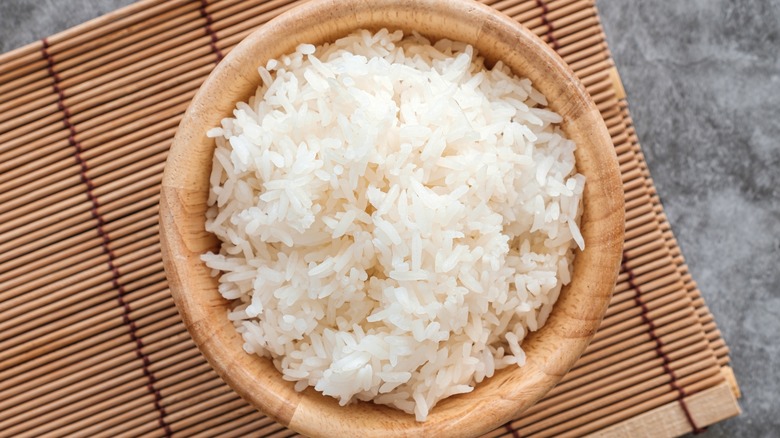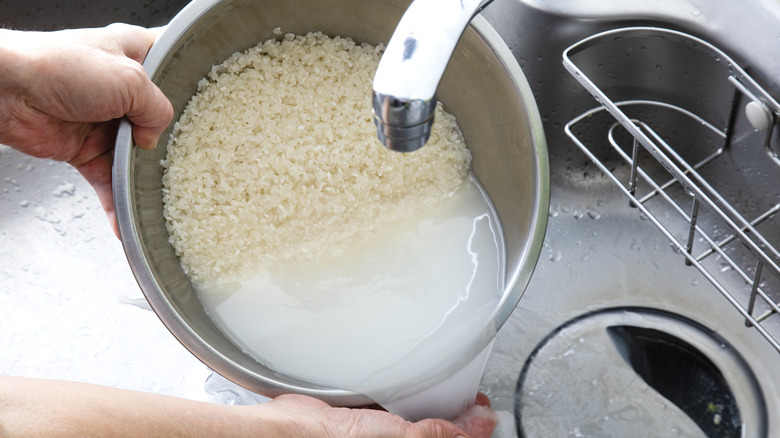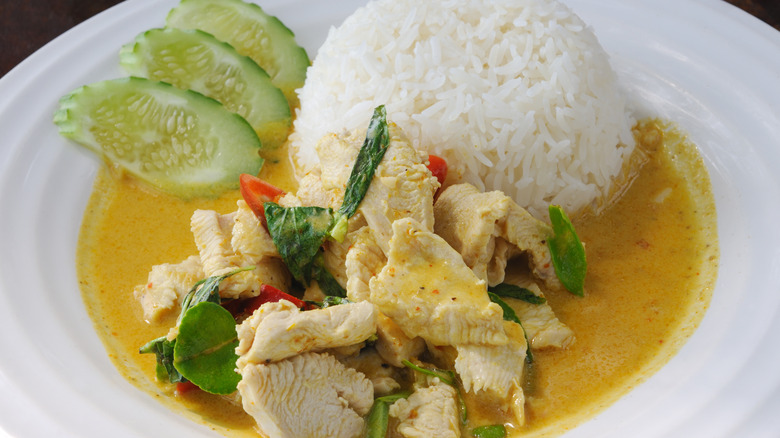For Soft, Fluffy Coconut Rice, Choose Water Over Milk
Making perfect rice takes quite a bit of trial and error. Rice cooker or stove top, short grain or long grain, jasmine or basmati, the brand, the water ratio, toasting the grains or boiling them straight away — all of these choices factor into how the final product will turn out.
Given all those variables, subbing the water for coconut milk can lead to disaster. Rice made with coconut milk is delicious when done right, but it requires a real understanding of how your rice of choice, pot, and stove are all going to behave. Because of the high-fat content and thicker consistency, the rice doesn't absorb the liquid in the same way, which can result in a stodgy mess.
Instead, choose water over milk — coconut water, that is. Andrea Nguyen, author of "Vietnamese Food Any Day," substitutes coconut water for plain water. Coconut water texturally is very similar to plain water, so it hydrates the grains well and imparts a delightful tropical flavor. She also uses fresh turmeric, but that's totally optional if you are after a more coconut-forward side dish.
To wash or not to wash
Everyone has their own opinions, but across Asia, washing rice is key. Not only does washing remove debris and sediment from the rice, but it also rinses off excess starch. Once cooked, the powdery starches on the outside of the rice can create a gummy and sticky final product. If you are after a fluffy, pleasantly chewy batch of rice where each grain maintains its integrity, then definitely wash your rice.
Cookbook author Andrea Nguyen suggests putting uncooked long-grain jasmine rice in a bowl or your cooking pot, covering it with cold tap water and swishing the grains around with your fingers. Pour off the starchy water and repeat at least 2 – 3 times or until after agitating the rice in the water, the water runs somewhat clear. This should take a minute or two. Place the rice in a mesh strainer and drain well.
How to make coconut rice
Rice to liquid ratios that recipes recommend vary significantly. Here, Nguyen uses nearly equal parts – 1 ½ cups rice to 1 ¾ cups coconut water. Unlike some methods, like Alton Brown's fluffy stovetop rice, this technique does not require the rice to be sauteed in oil first. Instead, bring the rice, coconut water and salt to a boil. Once boiling, reduce the heat to medium and let it bubble away for a few minutes, giving the mixture a few stirs. Reduce the flame to low and cook covered for 10 minutes. Then, cut the heat and allow the rice to steam for another 10 minutes without removing the lid.
The coconut water is easily absorbed by the rice, just like regular water, but imparts a subtle coconut flavor and aroma. However, to really boost flavor, Nguyen also recommends adding a healthy scoop of coconut oil at the end. Incorporate the melted oil as you fluff the rice with a fork.
The resulting coconut rice has a rich nuttiness from the oil and is perfumed with coconut from the inside out. Serve it with coconut-forward dishes like a Thai curry, crispy fried coconut shrimp, or poriyal, a South Indian vegetable stir-fry flavored with curry leaves, crunchy daal, and fresh coconut. Alternatively, just eat this rice straight out of the pot!



